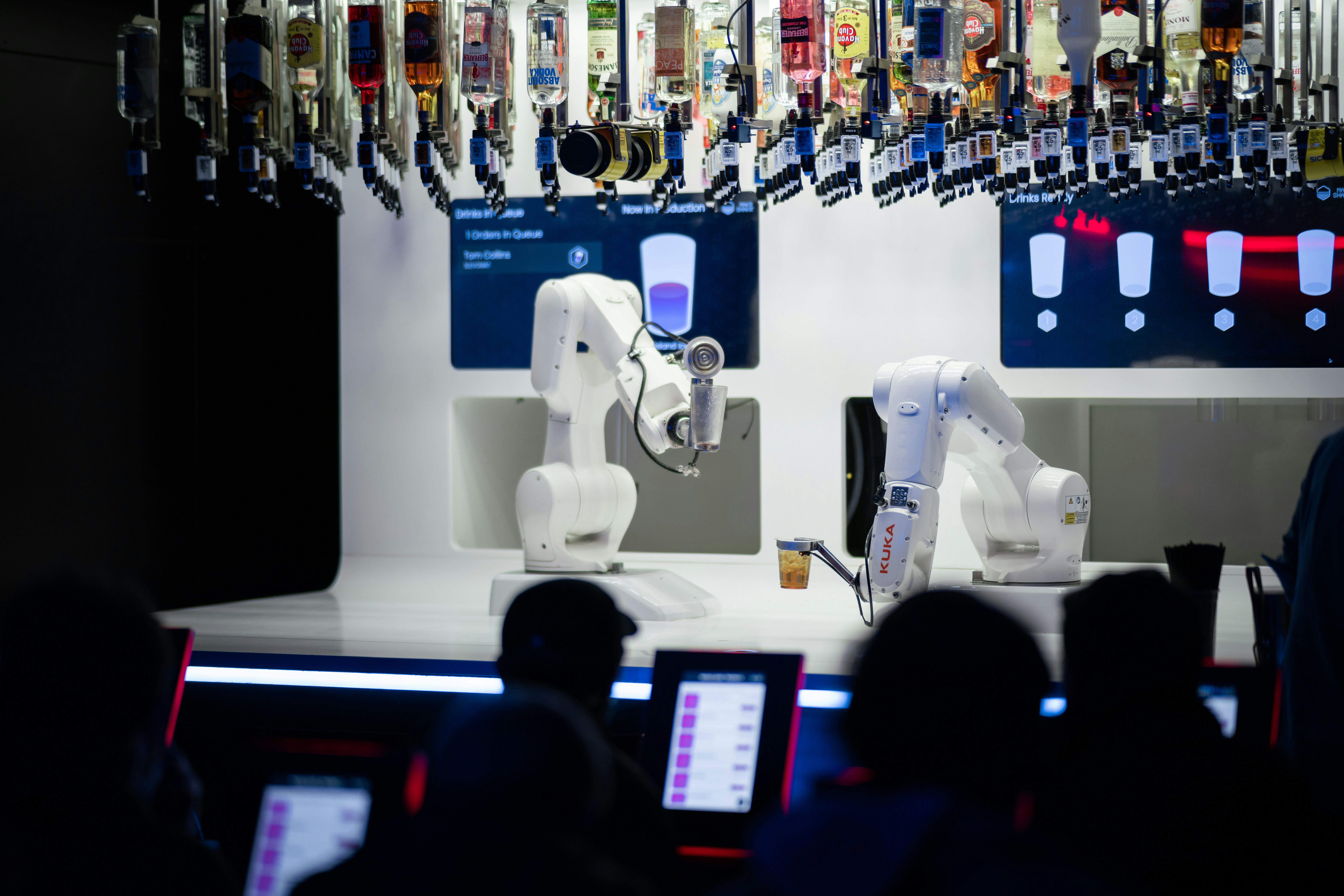
Robotics Jobs at Newly Funded UK Start-ups: Q3 2025 Investment Tracker
Robotics is swiftly transforming global industries—from manufacturing and agriculture to healthcare and logistics—by enhancing productivity, precision, and safety. In the United Kingdom, a long-standing engineering tradition, robust research ecosystem, and vibrant start-up culture have propelled robotics innovations to the forefront of tech development. This Q3 2025 Investment Tracker delves into newly funded robotics start-ups in the UK, spotlighting their missions, recent investments, and the roles they’re opening up for robotics professionals.
We’ll also demonstrate how job seekers can leverage these developments to secure high-impact roles via RoboticsJobs.co.uk, a dedicated platform for robotics professionals. Whether you’re a mechanical engineer, a software developer, a control systems expert, or an operations manager with a passion for robotics, read on to uncover the latest trends and next-wave opportunities in the UK’s thriving robotics landscape.
1. The UK’s Robotics Ecosystem: An Overview
Before examining the Q3 2025 highlights, let’s take a look at what makes the UK such fertile ground for robotics:
World-Class Research & Education
Institutions like Imperial College London, the University of Cambridge, and the University of Bristol fuel robotics innovation, producing cutting-edge spin-outs and top-tier graduates.
Active Funding Scene
London continues to attract venture capital and corporate investors, while emerging tech hubs in Manchester, Edinburgh, and Bristol host accelerators, labs, and incubators supporting robotics ventures.
Government Support
UK government initiatives—ranging from Innovate UK grants to the Catapult centres—offer dedicated resources for research, prototyping, and commercialisation in robotics and automation.
Industrial & Consumer Applications
The UK has a diverse industrial base (aerospace, automotive, healthcare, agriculture), providing robotics start-ups with ready partners and real-world test environments for advanced automation solutions.
By Q3 2025, this supportive setting has paved the way for a series of robotics-focused funding rounds, giving rise to an array of new job openings across software, hardware, and operational roles. Let’s see why these announcements are crucial for job seekers.
2. Why Q3 2025’s Funding Matters for Robotics Professionals
For individuals seeking new positions in robotics—be they graduates or seasoned engineers—following funding news offers a key advantage:
Immediate Hiring
Upon closing investment rounds, start-ups rapidly expand their teams to scale R&D, manufacturing, and commercial operations.
Competitive Compensation
Newly funded ventures often provide robust salaries and equity incentives—particularly in robotics, where technical expertise is at a premium.
Cross-Disciplinary Collaboration
Robotics integrates mechanical and electrical engineering, software, AI, and data analytics. Employees can grow multifaceted skill sets and shape next-generation solutions.
Impactful R&D
Early-stage start-ups allow you to influence product direction, refine prototypes, and see tangible results in real-world settings.
Potential for Rapid Growth
If the company successfully commercialises its robotics platform or technology, early hires can experience accelerated career trajectories and benefit from equity value.
With these benefits in mind, let’s explore Q3 2025’s newly funded UK robotics start-ups, each offering a distinct angle—and a suite of new job vacancies.
3. Q3 2025 Robotics Funding: A High-Level View
Even amid global economic fluctuations, UK robotics start-ups continue to draw significant investment, spanning manufacturing automation to autonomous vehicles and agritech. Below, we spotlight five companies that sealed fresh funding this quarter and are actively seeking new talent.
4. AutoNex Robotics – Advanced Autonomous Vehicles
Funding Round: Series B
Amount Raised: £15 million
Headquarters: Cambridge
Focus: Self-driving car and drone robotics
Company Snapshot
AutoNex Robotics—originally a spin-out from the University of Cambridge—develops autonomous navigation systems for ground and aerial vehicles. Their software-hardware integration ensures robust perception, real-time mapping, and collision avoidance even in dynamic environments. A hallmark is their multi-sensor fusion approach: combining LiDAR, radar, and cameras with AI algorithms to facilitate near-instantaneous decision-making. They’ve already completed pilot tests with drone deliveries and robotic taxis in closed environments.
Use of Funds
With £15 million in Series B:
Expand R&D
Integrate 5G/6G communications for low-latency remote monitoring, refine sensor fusion algorithms, and develop second-generation prototypes.
Commercial Pilots
Partner with local councils, logistics firms, and ride-share operators to launch larger-scale trials in the UK and EU.
Talent Acquisition
Bring on robotics software engineers, automotive hardware specialists, and deployment managers to support expansions into new markets.
Key Robotics Roles at AutoNex
Autonomous Vehicle Software Engineer
Responsibilities: Implement perception, mapping, and route-planning algorithms; ensure real-time performance in embedded systems.
Skills Needed: C++/Python, ROS (Robot Operating System), SLAM techniques, deep learning frameworks for sensor data.
Sensor Fusion Specialist
Responsibilities: Integrate LiDAR, radar, and camera feeds, calibrate multi-sensor arrays, address data synchronisation and noise reduction.
Skills Needed: Multi-sensor data processing, extended Kalman filters or particle filters, signal processing, GPU acceleration.
Aerial Robotics Engineer
Responsibilities: Adapt the AutoNex platform for drones, manage flight controllers, tune propulsion and control loops for stable UAV operations.
Skills Needed: UAV flight dynamics, aerodynamics, mission planning (PX4, ArduPilot), hardware testing in varied weather conditions.
Deployment & Field Test Manager
Responsibilities: Coordinate on-site trials with clients, oversee QA in real-world conditions, liaise with authorities for regulatory compliance.
Skills Needed: Project management, excellent communication, risk assessment, basic robotics troubleshooting.
AutoNex suits professionals eager to redefine mobility—blending robotics, AI, and advanced hardware to push autonomous transport forward.
5. RoboFab Solutions – Smart Manufacturing Automation
Funding Round: Seed
Amount Raised: £4 million
Headquarters: Manchester
Focus: Industrial automation and collaborative robots (cobots)
Company Snapshot
RoboFab Solutions aims to democratise smart factory automation by creating cost-effective, easily programmable robots for small and medium manufacturers. Their cobots can work alongside humans on assembly lines, handling repetitive tasks like welding, painting, or packaging. With intuitive drag-and-drop software, RoboFab’s systems reduce deployment complexity, making automation accessible to facilities that historically found robotics too expensive or complicated.
Use of Funds
After securing £4 million in seed funding, RoboFab Solutions will:
Refine Cobots
Improve safety sensors, expand multi-axis movement, enhance user-friendly programming interfaces.
Pilot Programmes
Partner with local manufacturers across automotive, consumer goods, and food sectors to showcase productivity gains.
Expand Team
Recruit mechanical/electrical engineers, robotics software developers, and customer success managers to handle pilot rollouts.
Key Robotics Roles at RoboFab
Mechanical Design Engineer (Cobots)
Responsibilities: Develop lightweight robotic arms, optimise gear ratios, ensure precise motion control under high throughput.
Skills Needed: CAD (SolidWorks/AutoCAD), FEA analysis, knowledge of actuator technologies, mechatronics integration.
Controls & Automation Engineer
Responsibilities: Design control loops, set up PLC/HMI systems, integrate sensors and motors with the robotics software stack.
Skills Needed: PLC programming, fieldbus protocols (EtherNet/IP, Modbus), motion control algorithms, industrial safety standards.
Robotics Software Developer
Responsibilities: Build cobot programming GUIs, manage firmware updates, integrate advanced path planning modules.
Skills Needed: C++/Python, ROS/ROS2, real-time OS, GUI frameworks, knowledge of kinematic solvers.
Application Engineer (Factory Automation)
Responsibilities: Work with clients to customise cobot tasks, adapt end-effectors, trial run solutions, troubleshoot on-site issues.
Skills Needed: Hands-on robotics experience, problem-solving under production constraints, good client-facing communication.
RoboFab’s mission to democratise automation makes it a strong match for those passionate about bringing advanced robotic solutions to everyday manufacturing floors.
6. AgriBotics – Robotics for Agriculture
Funding Round: Series A
Amount Raised: £9 million
Headquarters: Bristol
Focus: Autonomous farming systems, precision agriculture
Company Snapshot
AgriBotics pioneers field robots for sustainable and precise farming—using autonomous ground vehicles and drones equipped with AI-driven sensors to optimise planting, fertilising, and harvesting. By reducing pesticide use and labour costs, the company hopes to increase yield and profit margins while curbing environmental impact. Trials have already taken place in the West Country, proving the robots’ viability on crops ranging from wheat to strawberries.
Use of Funds
With £9 million Series A backing, AgriBotics will:
Diversify Robot Fleet
Design specialised bots for tasks like weed detection, selective spraying, or fruit picking, incorporate advanced machine vision.
Scale Production
Move from low-volume prototypes to a production line, lowering costs and improving reliability.
Enlarge R&D & Field Support
Hire agricultural experts, robotics engineers, and field technicians to refine solutions for various soil and climate conditions.
Key Robotics Roles at AgriBotics
Field Robotics Engineer (Agritech)
Responsibilities: Implement autonomous navigation in uneven, outdoor terrains, develop robust traction and obstacle avoidance solutions.
Skills Needed: ROS, sensor fusion, path planning, experience handling off-road or outdoor robotic systems.
Computer Vision Specialist
Responsibilities: Detect weeds, crop diseases, and growth stages via camera and hyperspectral imagery, develop AI for real-time recognition.
Skills Needed: Deep learning (PyTorch/TensorFlow), openCV, image segmentation, data annotation methods, agricultural domain knowledge a bonus.
Mechanical Technician (Field Trials)
Responsibilities: Maintain robots under harsh weather, assist with mechanical adjustments, document performance in test fields.
Skills Needed: Basic welding/fabrication, hydraulics, mechanical assembly, thoroughness in data reporting.
Agronomy Consultant (Robotics Integration)
Responsibilities: Advise on crop-specific needs, calibrate robots for spraying or seeding rates, interpret sensor data for yield improvements.
Skills Needed: Plant science background, agronomic best practices, good cross-functional communication, data analytics.
For experts keen on feeding the future with cutting-edge robotics, AgriBotics merges mechanical innovation, AI vision, and agronomic know-how.
7. MediMotion Robotics – Medical & Healthcare Automation
Funding Round: Series B
Amount Raised: £11 million
Headquarters: London
Focus: Robotic assistance for surgeries and patient care
Company Snapshot
MediMotion Robotics designs medical-grade robotic assistants for operating theatres and hospital wards. Their flagship robot handles tasks like instrument sterilisation, patient transport, and basic surgical tool passing, freeing healthcare staff for higher-level care. With a focus on safety and sterility, MediMotion’s integrated sensors, advanced control systems, and compliance with medical device regulations position them for broad hospital adoption.
Use of Funds
Following an £11 million Series B:
Enhanced Robotics Platform
Improve arm dexterity, ensure easy integration with hospital IT systems, bolster sanitisation features.
Clinical Trials & Certification
Undertake multi-centre trials to satisfy NHS and EU medical device regulations, gather real-world usage data.
Team Expansion
Employ mechanical, software, and medical device experts to scale solutions and drive market penetration.
Key Robotics Roles at MediMotion
Surgical Robotics Engineer
Responsibilities: Design manipulators for handling surgical instruments, ensure precise, contamination-resistant movement.
Skills Needed: Medical device ISO standards, mechatronics, haptic feedback, real-time controls.
Healthcare Integration Specialist
Responsibilities: Interface with hospital IT systems (patient tracking, EHR), customise user workflows, handle data security compliance.
Skills Needed: HL7/FHIR knowledge, cybersecurity, user experience in clinical environments, vendor liaison.
Regulatory Affairs Manager
Responsibilities: Oversee CE marking, handle MHRA documentation, coordinate clinical evidence collection, maintain QMS to ISO 13485.
Skills Needed: Medtech regulatory expertise, strong documentation and auditing skills, thorough knowledge of device certification steps.
Service & Support Engineer (Hospitals)
Responsibilities: Install and maintain robots on-site, train clinical staff, troubleshoot malfunctions under operating theatre conditions.
Skills Needed: Electrical/mechanical repair, strong communication, flexible schedule, adherence to hospital protocols.
For engineers passionate about improving patient care via robotics, MediMotion offers a chance to embed advanced automation into healthcare settings.
8. GreenLine Robotics – Sustainable Infrastructure & Inspection
Funding Round: Seed
Amount Raised: £3 million
Headquarters: Edinburgh
Focus: Robotic inspection and maintenance for green infrastructure
Company Snapshot
GreenLine Robotics develops inspection drones and crawlers for critical green infrastructure—wind turbines, solar farms, and hydropower facilities. Their machines navigate difficult terrains, using thermal imaging and ultrasonic sensors to spot wear, corrosion, or alignment issues, minimising human risk and downtime. By ensuring timely repairs and optimising energy output, GreenLine propels the transition to renewable energy sources.
Use of Funds
After a £3 million seed round, GreenLine will:
Refine Inspection Tech
Extend robots’ climbing and tethering capabilities, incorporate advanced 3D mapping, use AI for real-time fault detection.
Scale Field Trials
Collaborate with wind farm operators and utility providers to pilot solutions on remote sites across Scotland and northern England.
Grow Team
Recruit robotics engineers, GIS specialists, and sustainability analysts to expand services and support an evolving green energy market.
Key Robotics Roles at GreenLine
Field Robotics Engineer (Wind/Solar)
Responsibilities: Adapt robots for vertical climbs on turbines, rugged terrain navigation, maintain stable data feeds in harsh weather.
Skills Needed: ROS, motion planning, sensor fusion, real-time embedded software, resilience testing.
Computer Vision Developer
Responsibilities: Integrate cameras, LiDAR, or thermal imagers to detect micro cracks or corrosion, label and analyse inspection footage.
Skills Needed: openCV, deep learning, image segmentation, knowledge of structural defects in renewable assets is advantageous.
Environmental Data Analyst
Responsibilities: Provide insights on maintenance strategies, map environmental benefits of proactive repairs, produce sustainability impact reports.
Skills Needed: GIS software (ArcGIS/QGIS), basic stats (Python/R), data visualisation, renewable energy awareness.
Operations Coordinator (Site Deployments)
Responsibilities: Plan robot deployment schedules, secure site permits, ensure EHS compliance, coordinate logistics for remote locations.
Skills Needed: Project planning, knowledge of safety regulations, strong organisational skills, good stakeholder management.
For those wanting to combine robotics and sustainability, GreenLine offers roles that merge technical ingenuity with ecological impact.
9. Essential Skills & Qualifications for a Robotics Career
From these examples, we see common threads in robotics start-ups’ hiring needs:
Mechanical & Electrical Engineering
CAD design, mechatronics, actuator systems, PCB layout, sensor integration—fundamental for building the physical robot.
Control Systems & Software
Proficiency in C++/Python, ROS or ROS2, path planning algorithms, real-time OS, and integration with AI or computer vision frameworks.
Domain Specialisations
Sectors like healthcare, agriculture, or green energy each have unique regulatory standards and performance demands. Industry expertise adds value.
Teamwork & Cross-Functional Collaboration
Robotics often involves mechanical, software, electronics, and operations teams working in tandem. Communication is paramount.
Hardware Troubleshooting & Prototyping
Comfort with rapid iteration—testing prototypes in real-world conditions, diagnosing failures, refining designs quickly.
Machine Learning & Vision
Many robots require advanced perception, be it for object detection or mapping. Skills in deep learning or classical computer vision can be crucial.
Regulatory & Safety Knowledge
Understanding ISO safety standards for industrial robots (e.g., ISO 10218), or medical device regulations for healthcare systems.
Adaptability
Start-ups iterate rapidly, respond to user feedback, and pivot technologies. Versatile engineers who enjoy learning on the fly are prized.
10. How to Secure a Role at a Newly Funded Robotics Start-up
These roles are competitive, so consider the following:
Tailor Your CV & Portfolio
Highlight relevant robotics projects—be it university competitions, open-source ROS contributions, or prior industrial automation experience.
Showcase Real-World Results
Quantify achievements: “Reduced pick-and-place cycle time by 20%,” or “Implemented sensor fusion to improve SLAM accuracy by 30%.”
Demonstrate Sector Knowledge
If a start-up focuses on agriculture, highlight any agritech or outdoor robotics projects. For healthcare robotics, mention relevant medtech experience or certifications.
Network in Robotics Communities
Attend robotics events, hackathons, or local meetups. Engage in online forums (ROS Discourse, LinkedIn groups), share your expertise and ask for tips.
Stay Up-to-Date
Learn about next-gen sensors, AI breakthroughs, or hardware innovations. Subscribe to robotics publications or read academic papers if you’re doing advanced R&D.
Be Interview-Ready
Expect scenario-based and technical tests—like simulating a navigation challenge or diagnosing motor driver issues. Practice explaining your logic step by step.
Highlight Soft Skills
Start-ups value collaboration, problem-solving, and adaptability. Provide examples of cross-disciplinary work or times you overcame technical hurdles.
11. The Q4 2025 Outlook for UK Robotics
If Q3 is any guide, Q4 will continue the upward momentum:
Service Robots
More start-ups may tackle housekeeping, retail, or eldercare robots, propelled by ageing demographics and labour shortages.
Humanoid & Social Robots
With advances in AI-driven interaction, expect increased funding for robots capable of more nuanced human assistance or companionship.
Logistics & Warehouse Automation
The e-commerce boom persists, driving next-level picking, packing, and last-mile delivery solutions—an area ripe for robotics expansion.
Cobots for SMEs
We may see more user-friendly robotic arms and grippers, tailored for smaller factories or businesses seeking fast ROI.
Regulatory Developments
Greater clarity around safety standards and data usage could enable swifter adoption across public spaces, healthcare, and transportation.
Staying on top of these trends can help you identify future roles that align with your specialisations or interests.
12. Ready to Launch or Advance Your Robotics Career? Register on RoboticsJobs.co.uk
If these newly funded UK robotics start-ups have piqued your interest, the simplest way to connect with them is through RoboticsJobs.co.uk. We cater specifically to robotics professionals—be they mechanical designers, AI specialists, or team leads.
Why Register Your Profile?
Focused Robotics Listings
Save time wading through generic job boards by accessing curated roles spanning hardware, software, AI, automation, and more.
Personalised Alerts
Tailor your settings (location, salary, sector) to get notifications about fresh postings relevant to your skills and preferences.
Visible to Employers
Newly funded start-ups frequently search our candidate database before publicising roles, hoping to find talent quickly.
Showcase Your Portfolio
Upload a CV emphasising prior robot design or relevant software projects. Add links to GitHub, or mention robotics competitions you’ve taken part in.
Community & Resources
Access career advice, read robotics-focused blogs, and participate in forums discussing everything from sensor calibration to regulatory updates.
How to Get Started
Create Your Free Account
Head to RoboticsJobs.co.uk and click Sign Up.
Complete Your Profile
Highlight education (BSc/MSc/PhD in mechatronics, engineering, or computer science), relevant internships or jobs, and any unique robotics achievements.
Set Job Alerts
Choose “autonomous vehicles,” “cobots,” “agritech,” or other categories, plus your location and desired compensation. Receive targeted notifications.
Upload Your CV
Use bullet points, metrics, or project stories to illustrate your contributions—e.g., “Reduced robot calibration time by 50%,” “Implemented real-time path planning for 10% faster cycle times.”
Browse & Apply
Explore newly posted vacancies, including those from Q3’s funded start-ups (like AutoNex and RoboFab). Apply with a bespoke cover letter or our one-click method for certain positions.
Final Thoughts
The Q3 2025 funding announcements confirm the UK’s position as a robust robotics hub, attracting capital for solutions in autonomous transport, smart factories, agritech, healthcare automation, and green infrastructure. For job seekers, these developments signal a wealth of new roles—from designing next-generation robot arms to spearheading field trials in challenging settings.
By registering on RoboticsJobs.co.uk, you can position yourself at the heart of these innovations—whether your background is in AI software, mechanical engineering, project management, or beyond. With the right blend of technical prowess, collaboration skills, and forward-thinking attitude, you can seize the fresh opportunities emerging from the UK’s newly funded robotics start-ups and help shape a future where robots elevate every aspect of our lives.


